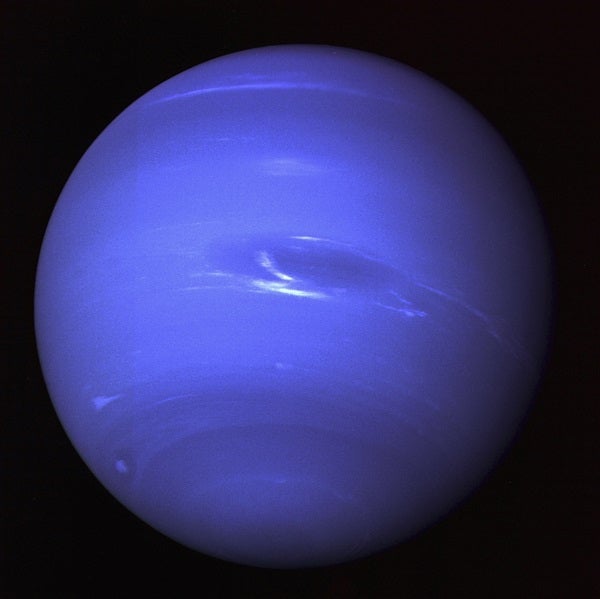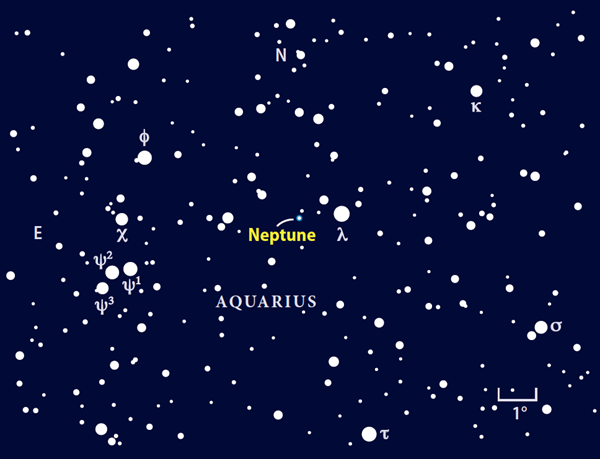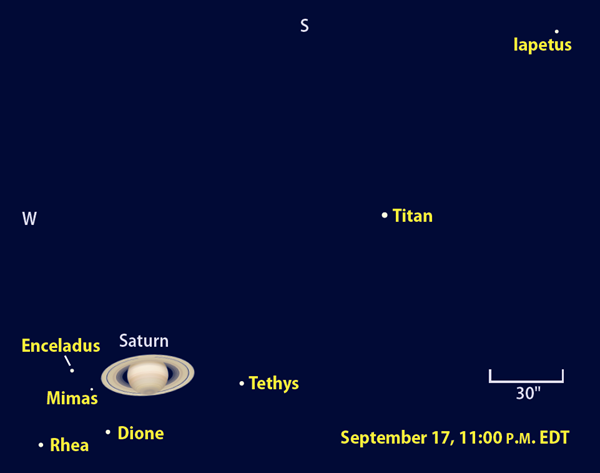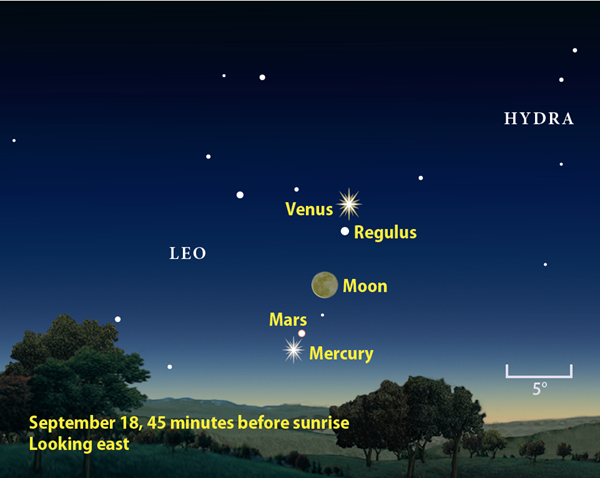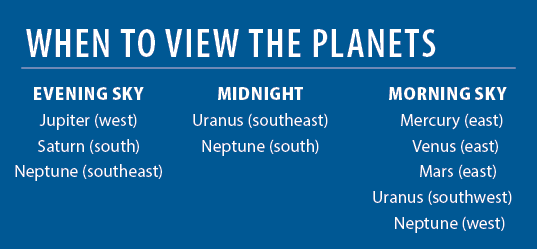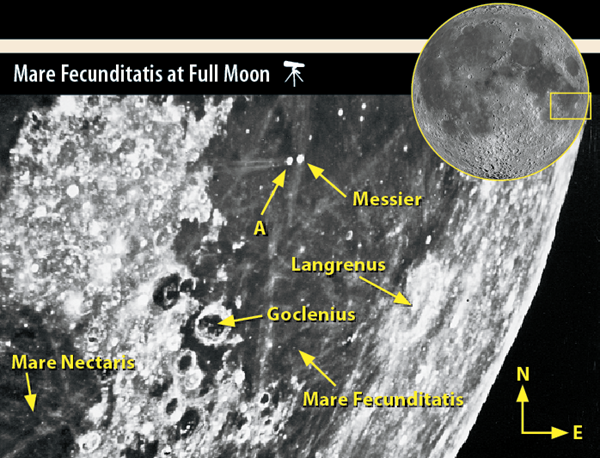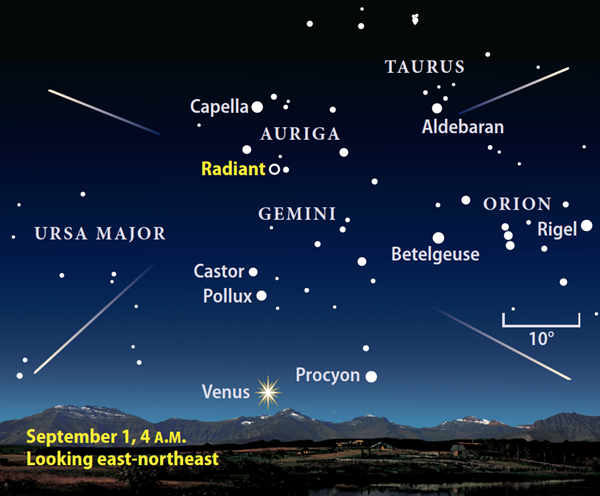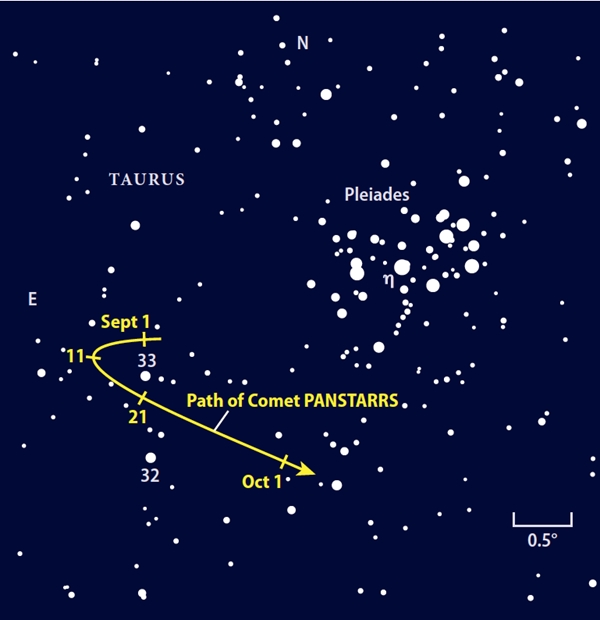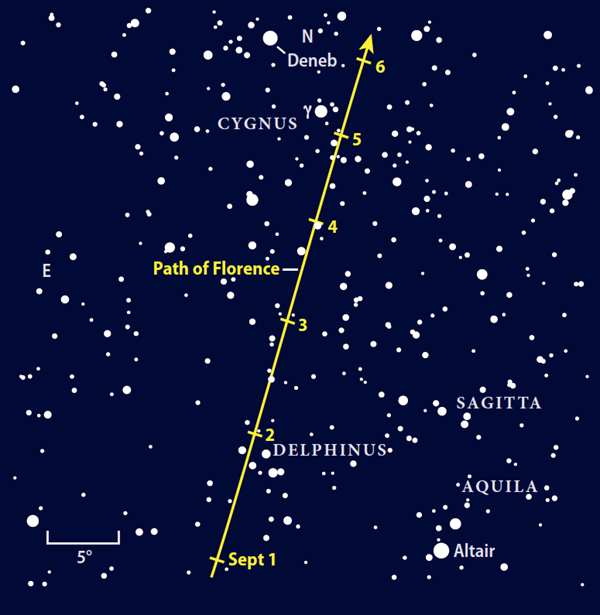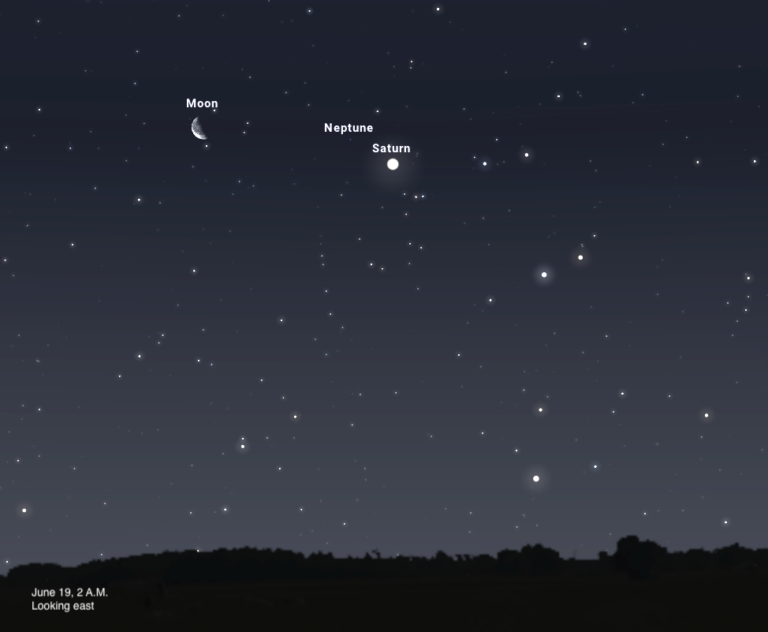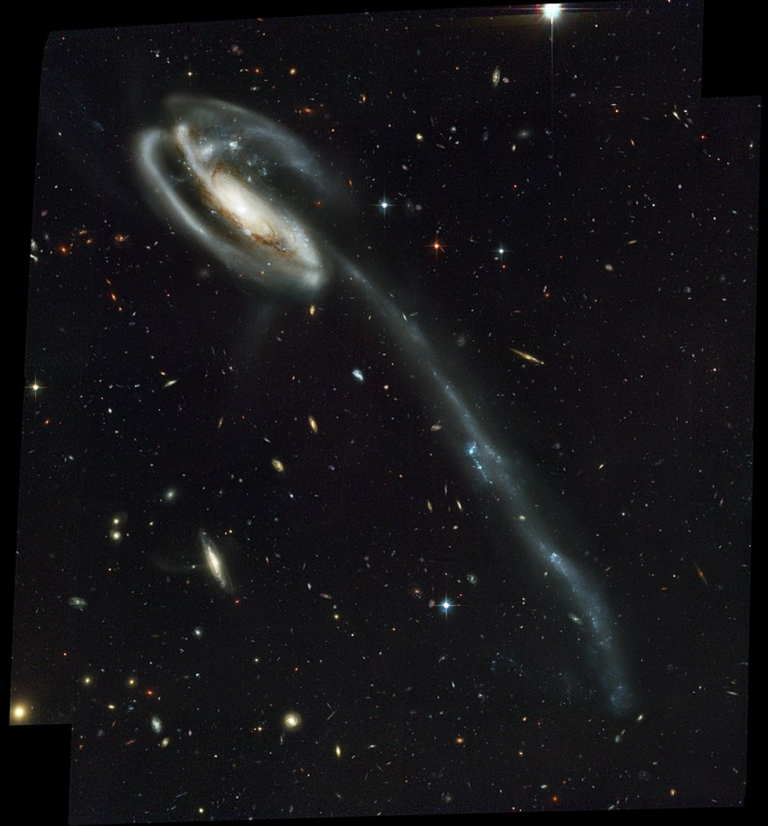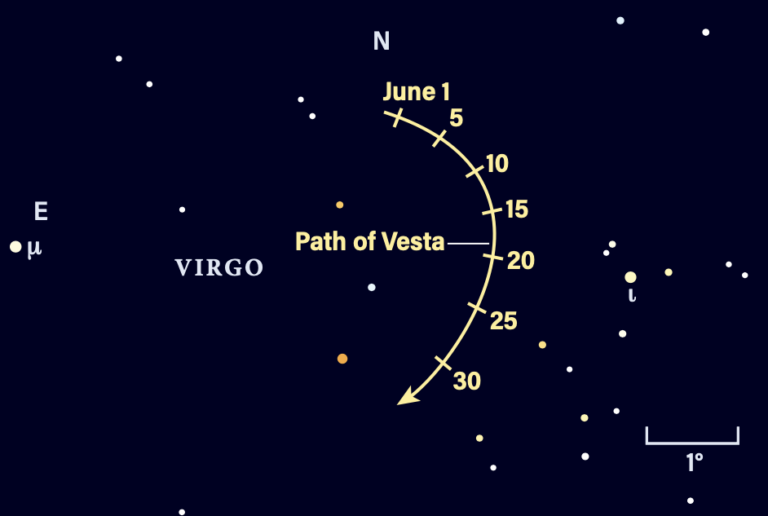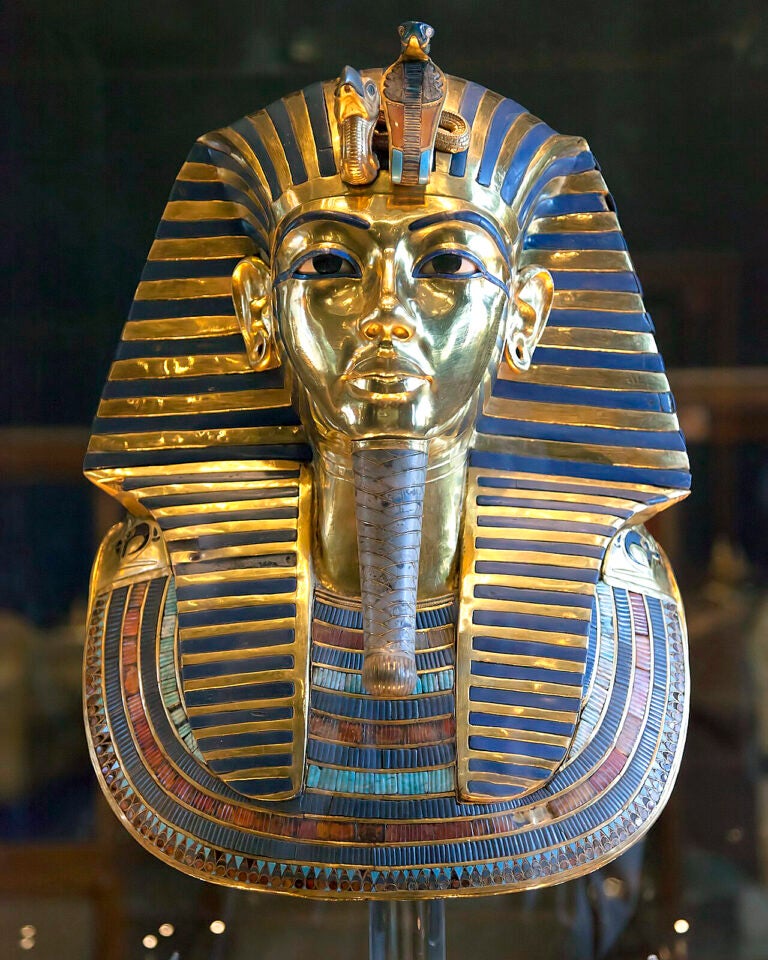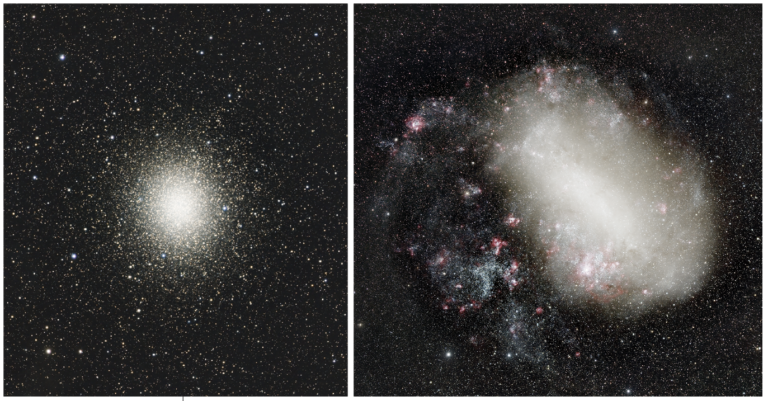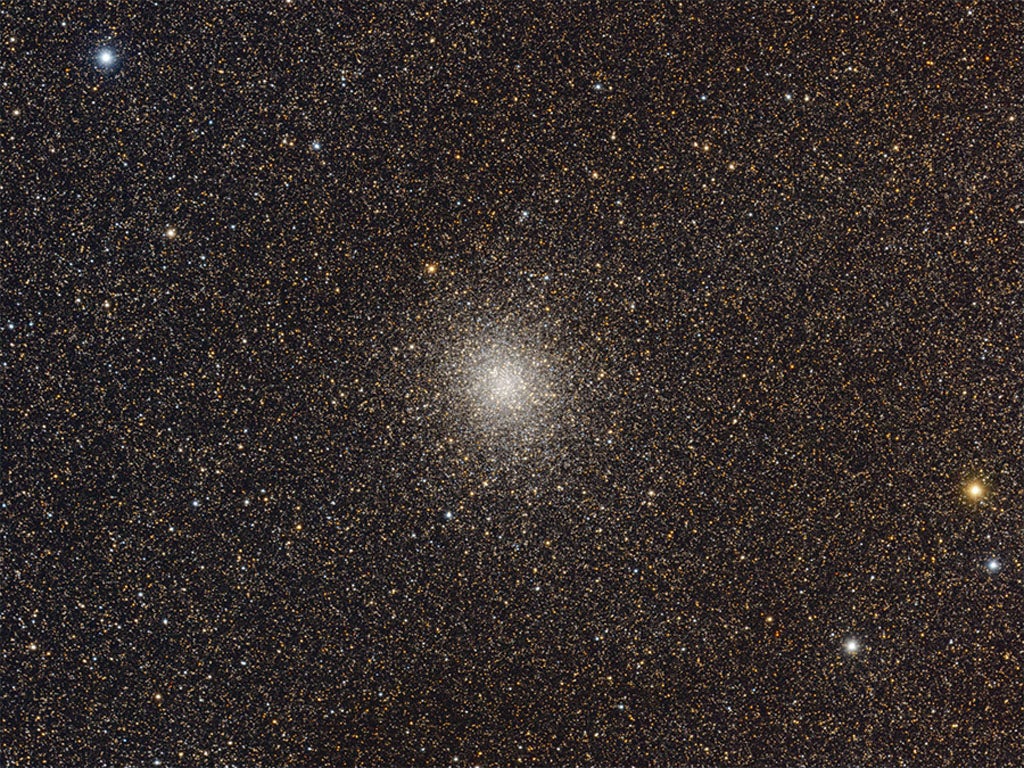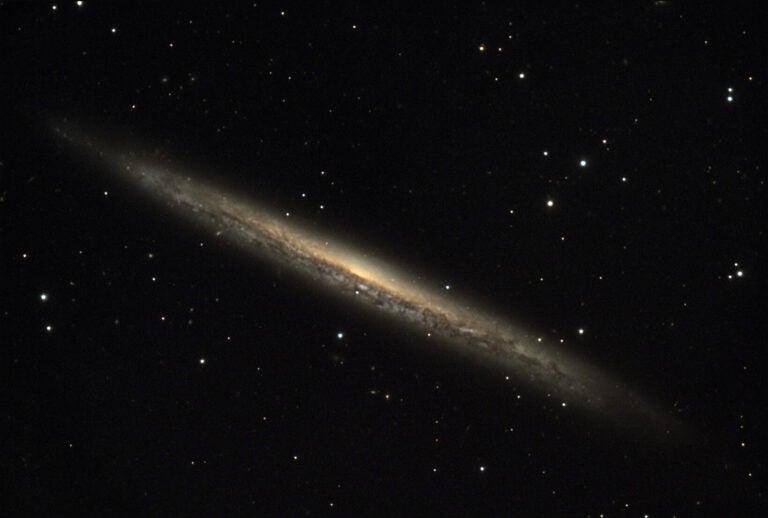Predawn observers can feast their eyes on Earth’s neighbors in the inner solar system. Mercury makes its finest morning appearance of the year in mid-September, coincidentally around the same time that it skims within 1° of Mars. Meanwhile, brilliant Venus rules over its two siblings from higher in the eastern sky. But the highlight of this predawn gathering comes during September’s third week, when the waning crescent Moon slides past the three planets.
The first object you’ll want to target these autumn nights is Jupiter. Although the giant planet has been spectacular all year, its days are numbered. The world hangs low in the west-southwest during evening twilight all month. It sets within two hours of the Sun in early September and less than an hour after sundown late in the month.
Jupiter lies among the background stars of Virgo. It spends most of September within 4° of the Maiden’s luminary, 1st-magnitude Spica, passing 3° due north of this star on the 5th. At magnitude –1.7, the planet appears 12 times brighter than the star.
If you plan to target Jupiter through a telescope, do so early in the month when it lies about 10° high 45 minutes after sunset. Because of its low altitude, Jupiter won’t show much detail on its 32″-diameter disk. Still, you should see the planet’s two dark equatorial belts and up to four bright moons.
After a quick view of Jupiter, turn your attention toward Saturn. The magnitude 0.5 ringed planet stands nearly 30° above the southern horizon soon after sunset. As the sky darkens, look for 1st-magnitude Antares 13° west-southwest of Saturn. The planet’s yellow color, which comes from reflected sunlight, contrasts nicely with the intrinsic orange glow of the distant red supergiant star.
Saturn resides in southern Ophiuchus near 4th-magnitude Xi (ξ) Ophiuchi. The planet begins September 0.9° due south of Xi and moves to a position 1.4° southeast of the star by month’s end. The pair sets just before 12:30 a.m. local daylight time on the 1st and about a half-hour earlier with each passing week.
Modest scopes also reveal several of the ringed world’s moons. The brightest is 8th-magnitude Titan, an easy target through any scope. It approaches within 1.3′ of Saturn when it passes north (September 11 and 27) or south (the 3rd and 19th) of the planet. The moon strays up to 2.9′ from the gas giant at greatest eastern and western elongation.
While it takes Titan 16 days to orbit Saturn, five dimmer moons complete their circuits in less than five days. Tethys, Dione, and Rhea glow at 10th magnitude and show up through 4-inch scopes on any clear night.
To capture 12th-magnitude Enceladus or 13th-magnitude Mimas, you’ll need at least a 6-inch instrument with good optics. The former revolves around Saturn in 33 hours while the latter takes 23 hours. Both lie near the rings’ edge and often get lost in the glare. Your best bet is to look for them September 17, when they reach greatest western elongation within two hours of each other.
Coincidentally, the 17th is also the best evening to look for Iapetus, which takes 79 days to orbit Saturn. If you draw a line from Saturn to Titan and then extend it an equal distance, Iapetus will be right there. A 4-inch scope reveals this moon’s 11th-magnitude glow.
While you gaze upon the ringed planet this month, the Cassini spacecraft is wrapping up its extraordinary 13-year mission exploring the Saturn system. The probe makes its final two orbits in early September, diving through the 1,500-mile-wide gap between the planet’s cloud tops and the inner edge of the rings. The mission comes to an end when the spacecraft plunges into Saturn’s atmosphere September 15.
For an outer planet, opposition typically coincides with best visibility. But on the evenings of the 4th and 5th, the Full Moon lies near Neptune and makes viewing difficult. Fortunately, the planet shines at magnitude 7.8 all month, so you can find it with equal ease on any clear night.
Grab your binoculars and center 4th-magnitude Lambda (λ) Aquarii in your field of view. In early September, Neptune lies 1.2° due east of Lambda. The planet’s westward motion brings it 0.7° southeast of the star by month’s end.
Neptune passes just 1′ south of an 8th-magnitude background star the night of September 18/19. Although the similarly bright objects may be hard to identify through binoculars, a telescope will tell you which is which. Only Neptune shows a distinct disk, which measures 2.4″ across and appears blue-gray.
Uranus tracks across the sky a couple of hours behind Neptune. You can start to look for Uranus once it climbs clear of the eastern horizon in late evening. It glows at magnitude 5.7, making it an easy binocular target and visible to the naked eye under a dark sky.
Uranus resides among the background stars of Pisces, not far from 4th-magnitude Omicron (ο) Piscium. The planet stands 1.0° north of this star September 1 and moves to a point 1.2° northwest of it by the 30th. A telescope reveals Uranus’ distinctive blue-green disk, which spans 3.7″.
You’ll have to wait until early morning to catch sight of the inner planets. Venus appears first, rising in a dark sky more than two hours before the Sun and standing high in the east as dawn breaks. You won’t mistake the planet for anything else — at magnitude –3.9, it far outshines every other point of light in the sky. Don’t miss Venus passing 1° south of the magnificent Beehive star cluster (M44) the mornings of September 1 and 2. The pair makes a lovely binocular sight and a stunning photographic composition.
Mercury reaches the peak of its best morning appearance of the year September 12. It then lies 18° west of the Sun and stands 11° high in the east a half-hour before sunrise. Shining at magnitude –0.4, it appears conspicuous in morning twilight. Use binoculars to pick out magnitude 1.8 Mars 3° to Mercury’s lower left.
These planets pull closer over the next few days. On the 16th, they come within 10′ of each other and appear in the same low-power field through a telescope. (Mercury spans 6.4″ and is about two-thirds lit; Mars is 3.6″ across and full.)
A waning crescent Moon adds to the scene on the 17th. The slim crescent hangs 6° above Venus with Leo’s brightest star, magnitude 1.4 Regulus, 3° below the planet. Mars and Mercury huddle 11° below Venus.
The solar system fireworks peak September 18. A wafer-thin crescent Moon then lies below Venus and above the Mercury-Mars pair, with just 1.5° separating the latter two planets. While Venus and Mars shine as brightly as they did earlier in the month, Mercury has improved to magnitude –1.0.
The next two mornings see Venus pass within 1° of Regulus, but that’s the last September conjunction. Mercury quickly falls back toward the Sun and disappears from view in the month’s final week. Meanwhile, Mars climbs higher before dawn. By the 30th, it approaches within 3° of Venus, setting the stage for a close conjunction in early October.
To the eyes of a beginning lunar observer, the terrific ray system radiating from the crater Tycho is perhaps the Full Moon’s most impressive feature. These rays — bright material ejected during the relatively recent impact that gouged out Tycho — stand out best within two days of the September 5/6 Full Moon.
Let’s follow one of Tycho’s prominent rays that angles northeast and eventually cuts across Mare Fecunditatis (Sea of Fertility). This ray first passes through Mare Nectaris (Sea of Nectar), where it nearly pierces the small crater Rosse.
After crossing highland terrain, the ray seems to skip over the crater Goclenius. It then continues across the rest of Mare Fecunditatis. Some scientists suspect that the greater elevations of the highlands and crater rims produced “ray shadows” where Tycho’s ejecta could not fall.
Two other ray systems cross the Sea of Fertility. On the eastern shore, numerous short rays spread out from the crater Langrenus like spokes on a bicycle wheel. And in the mare’s north-central section, you can’t miss the dual rays shooting out of the crater Messier A.
The incessant weathering of the solar wind darkens these lighter streaks over time, but they likely won’t fade completely from view for hundreds of millions of years.
September is a quiet month on the meteor calendar. The best of the minor showers is the Aurigids, which peaks September 1. Although observers have noticed occasional bursts in the past century, astronomers don’t anticipate any this year. The best views should come shortly before dawn, once the waxing gibbous Moon has set and the radiant climbs high. Under a dark sky, observers can expect to see an average of six meteors per hour emanating from the constellation Auriga.
The tiny dust particles that give rise to meteors when they burn up in Earth’s atmosphere also permeate the inner solar system. Their combined glow shows up as the zodiacal light in the predawn hours of September’s final two weeks. With the Moon then out of the way, viewers at dark sites can see this cone-shaped glow above the eastern horizon. The zodiacal light aligns with the ecliptic, so Venus serves as a guide for finding it.
Although the brighter comets of spring may be gone, the pleasures of viewing fainter comets from a dark site at this time of year shouldn’t be overlooked. First, you get to see the magnificent Milky Way emerge out of the dusk; then, the Cygnus star clouds take over at midnight; and finally, the sparkling stars of winter splash across the sky before daybreak.
Comet PANSTARRS (C/2015 ER61) enjoys the company of one of winter’s finest star clusters. The comet remains within 3° of the Pleiades (M45), or Seven Sisters, throughout September. The month begins with a few Moon-free mornings, when the comet and cluster ride high in the southeast. A second window opens once our satellite wanes to a slim crescent in mid-September. For the rest of the month, you can view the comet starting around midnight local daylight time and continuing until it passes nearly overhead before morning twilight begins.
This 10th-magnitude comet shadows the Pleiades all month. It begins September nearly due east of the cluster, then heads slowly east before reversing course and moving more quickly to the south and west. Experienced observers won’t have trouble viewing PANSTARRS through a 4-inch telescope, but you might need a 6- or 8-inch instrument to see fine details.
Except for the Moon and a handful of comets, it’s rare to see a reasonably bright object move against the background stars in real time. But occasionally we get lucky and receive advance notice of a 10th-magnitude or brighter near-Earth asteroid destined to whiz across the sky. September’s first week gives observers the chance to see such a space rock hurtle across the evening sky.
Asteroid 3122 Florence — named after British nursing pioneer Florence Nightingale — is perfectly placed for evening viewing from the Northern Hemisphere. It comes closest to Earth on September 1, when it sweeps within 4.4 million miles of our planet and appears among the background stars of eastern Delphinus. By the next evening, it has shifted into northern Delphinus. Florence moves at some 9° per day, which translates into 22″ per minute. (In comparison, Jupiter currently spans 32″.)
Florence glows at 9th magnitude on September’s first three nights and dims to 10th magnitude the following three nights. On the 5th, it sweeps 1° west of 2nd-magnitude Gamma (γ) Cygni, the central star of Cygnus the Swan. But by then its motion has slowed to nearly half of what it was at the beginning of the month.
Astronomers classify Florence as an Amor asteroid, which means it comes close to but does not actually cross Earth’s orbit. If you scaled our planet’s orbit to the size of a dinner plate, Florence would come within 0.2 inch of its outer edge. At its farthest, Florence reaches halfway to Jupiter. The asteroid orbits the Sun once every 2.35 years, but this is its closest approach to Earth since 1890, and it won’t be as close again until after 2500.

